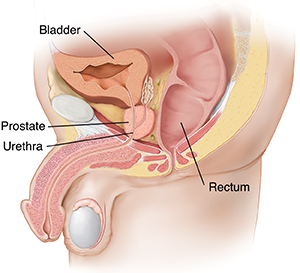Prostate Cancer: Introduction
What is cancer?
Cancer starts when cells in the body change (mutate) and grow out of control. To help you understand what happens when you have cancer, let’s look at how your body works normally. Your body is made up of tiny building blocks called cells. Normal cells grow when your body needs them, and die when your body doesn't need them any more.
Cancer is made up of abnormal cells that grow even though your body doesn’t need them. In most cancers, the abnormal cells grow to form a lump or mass called a tumor. If cancer cells are in the body long enough, they can grow into (invade) nearby areas. They can even spread to other parts of the body (metastasis).
What is prostate cancer?
Prostate cancer is the second most common cancer in men in the U.S. (after skin cancer). It's mostly found in older men. And in most cases, it's found before it has spread to other parts of the body. Cancer that hasn’t spread tends to be easier to treat and cure.
Understanding the prostate
The prostate is a sex gland in men. It's about the size of a walnut, but it can grow larger as men age. It sits below the bladder and in front of the rectum. It surrounds the upper part of the urethra. This is the tube that carries urine and semen out of the body. The prostate is part muscle and part gland. It has ducts that open into the urethra.
The prostate gland’s main purpose is to secrete a fluid that makes up most of semen (the fluid that carries sperm). Prostate fluid is made in the gland cells of the prostate. During a man’s orgasm, the muscle parts of the prostate help to send the prostate fluid into the urethra. There, it’s mixed with other fluids and sperm that were made in the testicles to form semen. The semen then leaves the body through the penis during ejaculation.

What are the different types of prostate cancer?
Nearly all types of prostate cancer start in the gland cells that make the prostate fluid. These cancers are called adenocarcinomas. Other types of cancer can also start in the prostate. These include small cell carcinoma, transitional cell carcinoma, and sarcoma. But these types of cancer are rare. Most men with prostate cancer have adenocarcinoma.
Other types of growths can form in the prostate. Some of these are not cancer. They are benign growths. Other kinds of growths in the prostate include:
-
Benign prostatic hyperplasia (BPH). As a man ages, the prostate gets bigger. This can lead to BPH. It’s a common condition. BPH is not prostate cancer. It doesn't turn into prostate cancer. But BPH can cause the prostate to press on the urethra. This can lead to symptoms, such as trouble urinating, which might need to be treated.
-
Prostatic intraepithelial neoplasia (PIN). This is an abnormal growth of prostate cells that may be found with a prostate biopsy. It's not prostate cancer. PIN can be low grade or high grade. Low-grade PIN is common, especially as men get older. Most healthcare providers don’t think it's linked to prostate cancer risk. Men who have high-grade PIN have a higher chance of prostate cancer. More testing might be done and these men will be watched closely for signs of prostate cancer.
Prostate cancer growth and spread
Prostate cancer tends to grow slowly. This means it's often found and can be treated while it's still only in the prostate. In fact, some prostate cancers may not need to be treated right away. They can be watched and then treated if they start to grow. The first place cancer grows in the body is called the primary site or primary tumor.
If prostate cancer isn't treated and grows, it can spread into other parts of the prostate. Over time, it may grow outside of the prostate and into nearby tissues, like the bladder or colon. When cancer spreads to other parts of the body, it's called metastasis. Once the cancer has grown outside the prostate, it can spread to nearby lymph nodes, too. These are bean-sized glands all around the body that are part of the immune system. If prostate cancer spreads to distant parts of the body, it often goes to the bones first. It may also spread to other organs, like the lungs, liver, or brain.
Talk with your healthcare provider
If you have questions about prostate cancer, talk with your healthcare provider. Your healthcare provider can help you understand more about this cancer.